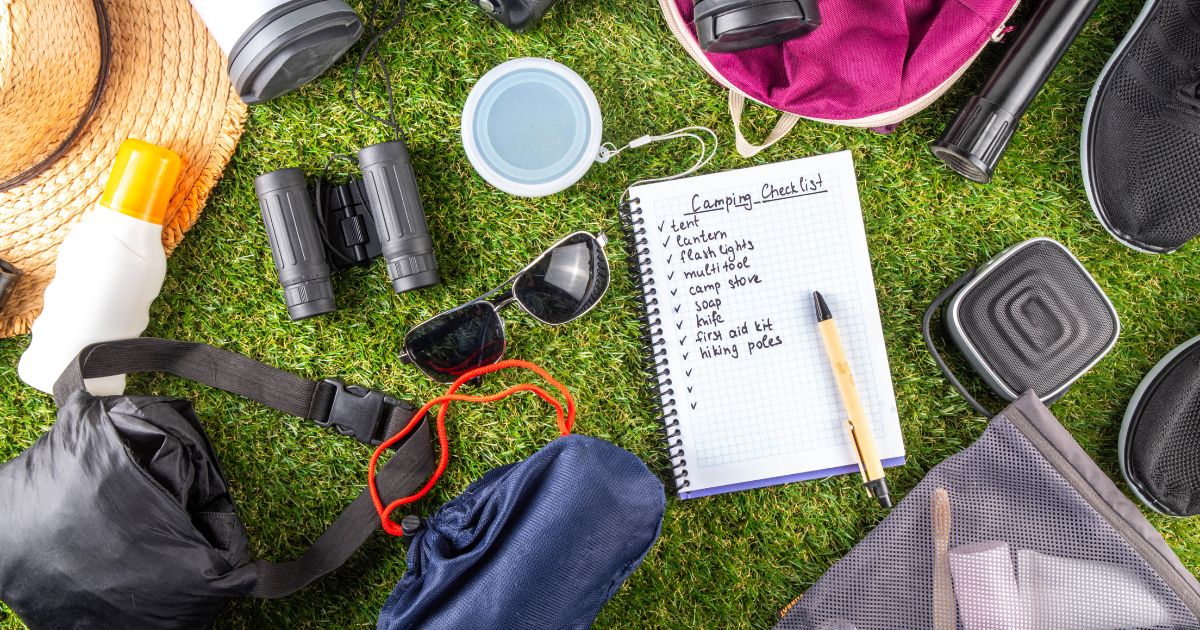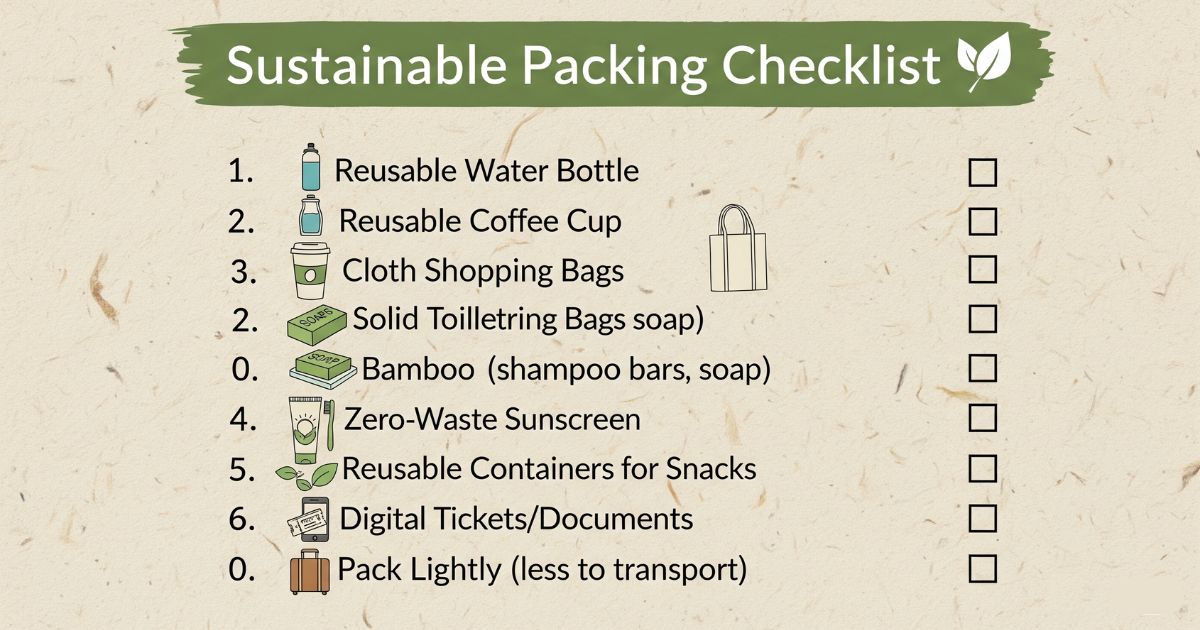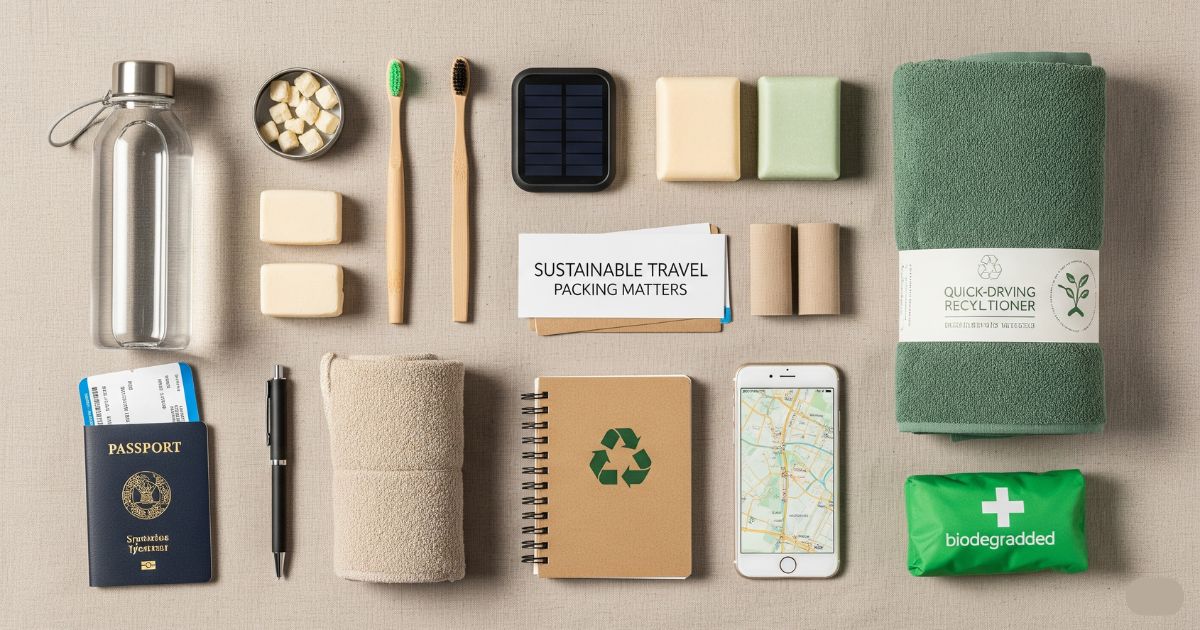
Most travelers pack with convenience in mind, grabbing whatever’s easiest from the drugstore shelf. But what if your next adventure could leave a smaller footprint on the planet without sacrificing comfort or practicality?
Sustainable packing isn’t about depriving yourself of travel essentials or carrying around heavy, impractical items. It’s about making smart swaps that reduce waste, eliminate single-use plastics, and often save you money in the long run. The best eco-friendly travel gear serves multiple purposes, lasts for years, and performs better than conventional alternatives.
This comprehensive guide will walk you through every aspect of sustainable packing, from choosing the right luggage to selecting versatile clothing and plastic-free toiletries. Whether you’re planning a weekend getaway or a month-long adventure, these strategies will help you travel responsibly while staying comfortable and organized.
Why Sustainable Packing Matters
The travel industry generates massive amounts of waste. Single-use toiletries from hotels, plastic water bottles, disposable utensils, and fast fashion clothing contribute to environmental degradation at every destination. A typical traveler can produce up to 4.6 pounds of waste per day while on vacation.
Sustainable packing addresses these issues by reducing your reliance on disposable items. When you bring reusable products, you’re not only minimizing waste but also avoiding the need to purchase items repeatedly during your travels. This approach saves money and ensures you have quality products you trust, regardless of what’s available at your destination.
Essential Sustainable Travel Gear for Every Trip

Reusable Water Solutions
A reusable water bottle should be the cornerstone of any eco-friendly packing list. Choose an insulated stainless steel bottle that keeps drinks cold for 24 hours and hot for 12 hours. Many airports now have water refill stations, and most destinations offer safe drinking water or affordable filtration options.
For areas where water quality is questionable, pack a portable water purification system. UV sterilizers or water purification tablets take up minimal space while ensuring you can safely drink local tap water instead of buying plastic bottles.
Consider a collapsible water bottle for hiking or day trips when space is limited. These silicone bottles fold down to a fraction of their full size but hold just as much water as traditional bottles.
Plastic-Free Toiletries
Traditional liquid toiletries create multiple problems for sustainable travelers. They’re packaged in plastic, subject to TSA liquid restrictions, and prone to spilling in luggage. Solid alternatives solve all these issues while lasting longer than their liquid counterparts.
A solid shampoo bar can replace both shampoo and conditioner, lasting 50-75 washes compared to a typical travel-sized bottle’s 10-15 uses. Look for bars made with natural ingredients that work well in different water types, especially if you’re traveling internationally.
Swap your plastic toothbrush for a bamboo toothbrush with soft bristles. Bamboo handles are biodegradable, and many brands offer replacement heads to extend the brush’s life. Pair it with toothpaste tablets or powder to eliminate plastic tubes entirely.
Replace disposable razors with a safety razor and metal blades. While the initial investment is higher, replacement blades cost pennies compared to disposable cartridge refills. Safety razors also provide a superior shave and significantly reduce plastic waste.
Reusable Food and Dining Items
Pack a set of lightweight, reusable utensils to avoid disposable cutlery at food courts, street vendors, and takeout restaurants. Bamboo or titanium sets are durable, lightweight, and often come with carrying cases.
A collapsible food container serves multiple purposes during travel. Use it for leftovers, market purchases, or packed lunches. Silicone containers collapse flat when empty but expand to hold substantial portions when needed.
Bring reusable produce bags for grocery shopping and market visits. These lightweight mesh or muslin bags prevent you from using plastic bags while shopping for snacks, souvenirs, or meal ingredients.
Versatile Clothing Choices
Minimalist packing reduces environmental impact while making travel more convenient. Choose clothing items that serve multiple purposes and coordinate well together.
Merino wool garments naturally resist odors, regulate temperature, and dry quickly. A single merino wool shirt can be worn multiple days without washing, reducing both luggage weight and laundry needs during travel.
Pack clothing in neutral colors that mix and match easily. A capsule wardrobe approach means bringing fewer items while creating more outfit combinations. Choose pieces that transition from day to night and casual to dressy with simple accessories.
Invest in quick-dry travel pants that look presentable enough for dinner but comfortable enough for hiking. Many brands now offer pants with hidden pockets, wrinkle resistance, and UV protection built in.
Zero-Waste Travel Essentials by Category

Personal Care and Hygiene
Create a plastic-free toiletry kit by switching to solid and powder alternatives. Solid deodorant in cardboard tubes eliminates plastic packaging while providing all-day protection. Look for brands that use natural ingredients and compostable packaging.
Replace makeup remover wipes with a reusable makeup removing cloth that only requires water. These microfiber cloths remove even waterproof makeup effectively and can be washed hundreds of times.
Pack a menstrual cup or reusable period underwear instead of disposable products. These alternatives last for years, take up minimal packing space, and eliminate the need to find suitable products abroad.
Technology and Electronics
Choose a universal travel adapter with multiple USB ports to charge several devices simultaneously. This reduces the number of chargers you need to pack while ensuring compatibility worldwide.
Bring a portable power bank made from sustainable materials. Solar-powered options work well for outdoor adventures, while traditional power banks ensure you stay connected without constantly seeking power outlets.
Pack rechargeable batteries and a compact charger instead of disposable batteries for cameras, flashlights, and other electronics. Rechargeable batteries perform better in extreme temperatures and save money over time.
Cleaning and Maintenance
Pack concentrated, biodegradable soap that works for body, hair, dishes, and laundry. Dr. Bronner’s soap is a popular choice that dilutes for various uses and comes in small containers perfect for travel.
Bring a microfiber towel that dries quickly and packs small. These towels absorb more water than traditional terry cloth towels while taking up a fraction of the space in your luggage.
Include a small sewing kit with neutral thread colors for quick repairs. A few minutes of mending can extend clothing life significantly and prevent the need to buy replacement items while traveling.
Smart Packing Strategies for Sustainability

Choose Quality Luggage
Invest in durable luggage that will last for decades rather than cheap options that break after a few trips. Hard-shell suitcases made from recycled materials offer excellent protection while supporting circular economy principles.
Consider luggage with built-in organization systems to maximize space efficiency. Internal compression zippers and packing cubes help you fit more items in less space, potentially allowing you to travel with smaller bags.
Look for luggage brands that offer repair services or replacement parts. Some companies will repair zippers, replace wheels, or fix handles, extending your luggage’s life significantly.
Maximize Multi-Purpose Items
Every item in your sustainable packing list should serve multiple functions. A sarong works as a towel, blanket, picnic mat, or privacy screen. A bandana functions as a washcloth, headband, napkin, or small bag.
Pack clothing that layers well for temperature regulation instead of bringing separate items for different climates. A lightweight merino wool base layer, insulating mid-layer, and waterproof outer shell can handle most weather conditions.
Choose accessories that serve multiple purposes. A watch with GPS eliminates the need for a separate navigation device. Sunglasses with interchangeable lenses work for various light conditions.
Prepare for Local Shopping
Research your destination’s local markets and shopping options before departure. Many places offer excellent locally-made products that are both sustainable and support local economies.
Leave space in your luggage for purchases, especially if you’re visiting destinations known for sustainable crafts or products. Buying locally-made items reduces shipping emissions compared to ordering online.
Plan to use consumable items completely during your trip rather than bringing excess that you’ll need to discard. Pack just enough toiletries and medications for your trip duration, plus a small buffer.
Advanced Sustainable Packing Tips
Climate-Specific Considerations
For tropical destinations, pack lightweight, breathable fabrics that dry quickly and resist wrinkles. Linen and bamboo clothing work well in humid climates while maintaining a polished appearance.
Cold-weather travel requires strategic layering with versatile pieces. A down jacket that compresses into its own pocket saves space while providing excellent warmth. Choose base layers that wick moisture effectively to stay comfortable during active days.
Desert climates demand sun protection and dust resistance. Pack clothing with UPF ratings and choose tightly-woven fabrics that prevent sand and dust penetration.
Transportation Method Adaptations
Air travel requires liquid restrictions compliance, making solid toiletries even more valuable. Pack sharp items like safety razors in checked luggage and ensure all containers meet TSA guidelines.
Road trip packing allows for larger reusable items like full-sized water bottles and extensive cooking equipment. Take advantage of the extra space to bring items that significantly reduce waste during longer journeys.
Train and bus travel often have weight restrictions similar to airlines, but different liquid rules. Research specific carrier policies to optimize your packing strategy.
Cultural Sensitivity and Local Customs
Research local dress codes and cultural expectations to pack appropriately. Bringing suitable clothing eliminates the need to purchase items abroad and shows respect for local customs.
Learn about local recycling and waste disposal systems at your destination. Some places have excellent recycling programs, while others may require you to carry out certain types of waste.
Understand local shopping customs and plastic bag policies. Some destinations charge for bags or have banned plastic bags entirely, making reusable bags even more essential.
Maintaining Your Sustainable Travel Gear
Proper Care and Storage
Clean and dry all reusable items thoroughly before storing them long-term. Moisture trapped in containers or clothing can lead to mold and premature wear.
Store solid toiletries in breathable containers rather than plastic bags. Cardboard or metal tins allow air circulation while protecting the products.
Rotate your travel gear regularly to ensure even wear. Using different items for different trips extends the overall life of your sustainable travel collection.
Repair and Replacement Strategies
Learn basic repair skills for your most important gear. Simple fixes like patching small holes or replacing buttons can significantly extend item lifespans.
Establish relationships with local repair services for complex items like luggage or electronics. Many cities have specialists who can restore damaged travel gear to like-new condition.
When items reach the end of their useful life, research proper disposal methods. Many sustainable brands offer take-back programs for recycling worn-out products.
Your Sustainable Travel Future
Sustainable packing represents more than just environmental responsibility—it’s a gateway to more intentional, meaningful travel experiences. When you carry quality items that serve multiple purposes, you spend less time managing gear and more time engaging with destinations and cultures. For many travelers, a Sustainable Travel Guide can provide helpful insights on how to pack smarter and reduce waste along the way.
The initial investment in sustainable travel gear pays dividends through years of use. A high-quality reusable water bottle costs less per use than constantly buying disposable bottles. Solid toiletries last longer than liquid versions while taking up less space in your luggage.
Start your sustainable packing journey gradually. Replace conventional items as they wear out rather than discarding functional products. This approach spreads costs over time while building a collection of gear that truly meets your travel needs.
Your choices as a traveler influence the tourism industry’s practices. When you consistently choose reusable products and support businesses with sustainable practices, you’re voting for the kind of travel industry you want to see in the future.

















No Comments